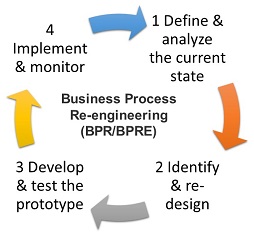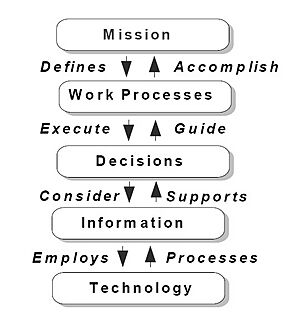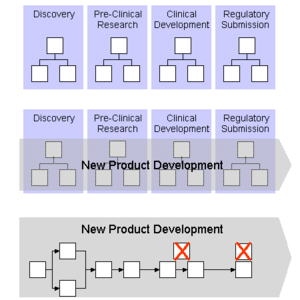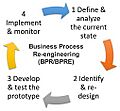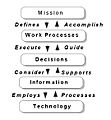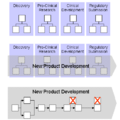Business process re-engineering facts for kids
Business process re-engineering (BPR) is a way for companies to completely rethink how they do things. It started in the early 1990s. The main goal is to look at how work flows and how business tasks are done. BPR helps organizations find new ways to work. This helps them serve customers better, lower costs, and become top competitors.
BPR helps companies totally change their structure. They focus on building their business processes from scratch. A business process is a group of related tasks done to reach a goal. BPR looks at the big picture of business goals. It encourages creating whole new processes, not just small fixes. New technology also influences BPR. Companies use new tools like automation to change how they operate and save money.
Business process re-engineering is also called business process redesign. Other names include business transformation or business process change management.
Contents
What is Business Process Re-engineering?
Business process re-engineering (BPR) is a big plan to make company processes better. It helps make things more efficient, effective, and able to adapt. This method changes how a business works. It looks at things like how work flows, how people talk to each other, and how decisions are made. The aim is to make big improvements. This includes making more products, lowering costs, and making customers happier.
BPR can be used in many different industries. It works for companies of all sizes. There are different ways to do BPR. These include mapping out processes, testing them, and using automation. Companies usually re-engineer two main areas. First, they use modern technology to share information and make decisions faster. Second, they change how teams are set up.
BPR starts by looking at the company's main goal and plans. It also checks what customers need. Questions like "Do we need a new goal?" or "Who are our customers?" are asked. A company might find it is working on old ideas. Only after rethinking what it should do, does it decide how to do it best.
BPR focuses on the company's business processes. These are the steps that guide how resources are used. They create products and services that meet customer needs. A business process is an organized set of work steps. It can be broken down into smaller activities. These can be measured, modeled, and improved. They can also be completely redesigned or removed. BPR finds, checks, and redesigns a company's main processes. This aims for big improvements in cost, quality, service, and speed.
BPR knows that a company's processes are often broken into smaller tasks. Different departments handle these tasks. Often, no one person is in charge of the whole process. BPR says that fixing small parts might help a little. But it won't make big changes if the whole process is old and inefficient. So, BPR focuses on redesigning the entire process. This brings the biggest benefits to the company and its customers. This idea of rethinking how work should be done makes BPR different. It's not just about making small, step-by-step improvements.
History of BPR
BPR started as a way for private companies to improve. It helped them serve customers better, cut costs, and compete globally. A key reason for BPR was the growth of information systems and computer networks. Companies became braver in using this technology. They used it to support new business processes, not just to make old ways faster.
The Idea of "Don't Automate, Obliterate" (1990)
In 1990, a professor named Michael Martin Hammer wrote an important article. It was called "Reengineering Work: Don't Automate, Obliterate." He said that managers often made a mistake. They used technology to make old, useless work faster. Instead, he argued, they should use technology to get rid of work that doesn't add value.
Hammer's idea was simple. Much of the work done doesn't help customers. This work should be removed, not sped up. Companies should instead fix their problems with customer needs and high costs. Other famous business thinkers also supported BPR. Many books and articles were written about it. Consulting firms also started offering BPR services.
However, some people criticized BPR. They said it made workplaces less human. They also said it was just an excuse for laying off many workers. Despite this, BPR became very popular. By 1993, many large companies were trying BPR. This trend grew because consulting firms adopted it quickly. Also, a study showed that many US companies were falling behind foreign competitors.
BPR After 1995
Around 1995, some early supporters of BPR started to criticize it. There were also some bad uses of the idea. Because of this, the excitement for re-engineering in the U.S. began to fade. Since then, thinking about business processes as a starting point has become normal. It's a common way to make changes. But it's usually done in a less extreme way than first suggested.
More recently, Business Process Management (BPM) has become popular. Many see it as the next step after BPR. It also aims for efficiency using technology. But like BPR, BPM is sometimes criticized for focusing too much on technology and not enough on people.
Key Ideas in BPR
The main ideas of re-engineering are:
- "Rethinking and radically redesigning business processes." This is to make big improvements in cost, quality, service, and speed.
- It means "imagining new work strategies." It also includes designing the process itself. And it involves putting the changes into practice. This covers technology, people, and how the organization works.
BPR is different from other ways of improving organizations. It aims for big, fundamental changes. Other methods often focus on small, step-by-step improvements. To get the big improvements BPR seeks, just changing how the company is structured is often not enough. Using information technology (IT) is seen as a major helper. IT used to just support existing tasks. Now, it helps create new ways of organizing and working together.
BPR uses ideas from different fields. Four main areas change in BPR: organization, technology, strategy, and people. A "process view" is used to connect these areas.
Business strategy is the main driver for BPR projects. The other areas follow the strategy. The organization part looks at how the company is built. This includes different levels and how work is shared. Technology is about using computer systems and other ways to communicate. In BPR, IT helps create new ways of working. It doesn't just support old ways. The people part deals with training, motivation, and rewards. The idea of business processes is central to BPR. These are linked activities that create value for a customer. They have features like process ownership, customer focus, adding value, and working across different departments.
The Role of Information Technology
Information technology (IT) has always been very important in BPR. Some people see it as a key tool for new ways of working. This includes working within a company and with other companies.
BPR ideas pointed out several "disruptive technologies." These were supposed to challenge old ideas about how work should be done:
- Shared databases: Making information available everywhere.
- Expert systems: Letting generalists do specialist tasks.
- Telecommunication networks: Allowing companies to be both central and spread out.
- Decision-support tools: Helping everyone make decisions.
- Wireless data communication and portable computers: Letting field workers work from anywhere.
- Automatic tracking: Letting things report their location.
- High performance computing: Allowing quick planning and changes.
In the mid-1990s, workflow management systems were seen as very helpful. Also, companies that made ERP (enterprise resource planning) software, like SAP, said their tools could help redesign business processes.
How BPR is Done
Early ways to do BPR, often linked to IT, shared similar basic ideas. Here's a simple way it might be done:
- Look at the company's structure with its different departments.
- Introduce a new cross-department process, like developing a new product.
- Reorganize and simplify activities. Remove tasks that don't add value.
Later, some BPR experts suggested focusing more on the customer. They also added checking risks and impacts. This was to see how BPR might affect jobs and operations. They also stressed using tools to manage change. This helps deal with people who might resist new ideas.
Some things to check when analyzing a process are: reduce handoffs (passing work between people), centralize data, reduce delays, free up resources faster, and combine similar activities. Many consulting firms also developed their own ways to do BPR.
One easy-to-follow plan is the INSPIRE framework. It has seven steps:
- Initiate: Start a new BPR project.
- Negotiate: Get approval from senior leaders.
- Select: Choose the main processes to change.
- Plan: Plan the BPR activities.
- Investigate: Look into the processes to find problems.
- Redesign: Change the chosen processes to make them better.
- Ensure: Make sure the new processes are put in place well.
Why BPR Succeeds or Fails
Many things are important for BPR to work well:
- Having the right people on the BPR team.
- Understanding the company's needs.
- Having good IT systems.
- Managing changes effectively.
- Always trying to improve.
BPR can change many parts of a business. This includes how teams are set up, how managers work, and what employees do. Big changes can lead to great success or complete failure.
If BPR works, it can improve quality, customer service, and how competitive a company is. It can also lower costs or speed up work. However, many BPR projects don't fully succeed.
There are many reasons why business processes might not be good:
- One department might be great, but it hurts another.
- Not enough time to focus on improving processes.
- Not realizing how big the problem is.
- Lack of training.
- People use simple tools like Microsoft Excel to fix complex problems.
- Bad IT systems.
- Too many rules and steps.
- Lack of motivation.
Many failed BPR attempts happened because people were confused. They didn't know what to change or how. So, BPR has been learned through trial and error. As more companies try BPR, we learn what makes it succeed or fail. For lasting benefits, companies must link BPR to their overall strategy. They need to measure strategy by cost and time. They must also accept the strategy throughout the company. And they need to connect strategy to their budget. Otherwise, BPR is just a quick fix for efficiency.
Company-Wide Commitment
Big changes to business processes affect how people work, technology, job roles, and company culture. Changing even one of these needs resources, money, and strong leaders. Changing them all at once is a huge task. Like any big project, BPR needs many experts. Since BPR can involve many parts of the company, it's important to get support from all affected departments. By including people from different departments, the company gets valuable ideas. This helps everyone cooperate and accept the new process.
Getting everyone in the company on board means:
- Top managers must support it.
- Workers who use the processes must agree.
- There must be a dedicated BPR team.
- Enough money must be set aside for the whole project.
Before any BPR project can work, top management must be committed. They need to understand BPR and plan how to achieve it. Leaders must be strong, visible, and creative. They need to provide a clear vision. Convincing every group in the company that BPR is needed is a key step. By telling all groups what's happening at every stage, and showing the good results, resistance to change can be reduced. The success of BPR depends on strong, steady involvement from all levels of the company.
The Right Team
Once everyone in the company agrees to the BPR effort, picking the right team is crucial. This team will be the core of the BPR effort. They will make key decisions and help explain the BPR plan to everyone. A good BPR team has:
- Skilled and motivated members.
- Members who are trusted in the company and are creative.
- The power to make decisions.
- Training in process mapping and brainstorming.
- Good leadership.
- Proper organization.
- Members with different skills.
- A good size (usually under ten people).
- Clear goals.
The best BPR teams include people from: top management, the business area being changed, technology groups, finance, and people who will use the new processes. Team members from each group will help make sure the new process meets their needs. The BPR team should have a mix of deep knowledge and new ideas. For example, it might include:
- People who know nothing about the process.
- People who know the process inside and out.
- Customers, if possible.
- Members from affected departments.
- One or two smart, passionate technology experts.
- Members from outside the company.
Keeping the team small helps make the process efficient. The team's goal is to find big opportunities. They design new work steps that will create huge gains and a competitive edge.
Good IT Systems
Experts say that checking and building good IT infrastructure is vital for successful BPR. IT helps challenge old ideas about how work should be done. Many researchers see IT systems as a key part of successful BPR efforts. Important IT factors include:
- Matching IT systems with BPR strategy.
- Building effective IT systems.
- Making smart IT investments.
- Measuring how well IT systems work.
- Properly connecting information systems.
- Updating old information systems.
- Improving IT skills.
- Using software tools effectively.
These factors help build good IT systems for business processes. BPR must also include a plan to use IT as a competitive tool. IT infrastructure includes physical tools, knowledge, shared services, and how they connect. How these parts are put together affects how well information can be delivered. Building good IT systems starts with the business strategy and IT strategy. Then it moves to designing data, systems, and computer architecture.
Connections between IT parts are important. They ensure that IT services work together. IT standards also help connect different parts. They provide shared IT services that support business processes. They also guide how IT tools are bought and used. The shared IT services and the people in IT are both vital. They help build the IT infrastructure. IT strategy is aligned by connecting business and IT strategies. It also connects IT and company structures.
Most experts see BPR and IT as strongly linked. For example, Walmart could not have changed its buying and distribution processes without IT. Ford cut its purchasing staff by 75 percent using IT with BPR. IT systems and BPR depend on each other. Deciding what information the new processes need helps determine the IT systems. And knowing what IT can do provides options for BPR. Building responsive IT systems depends on knowing the business process information needs. This depends on the activities in a process and how they rely on other company processes.
Managing Change Well
BPR involves changes in people's behavior, company culture, processes, and technology. Many things can stop BPR from working well. Change management is very important. It involves all the human and social changes needed. It also includes cultural adjustments. Management uses these to put new processes and structures into practice. It also helps deal with people who resist changes. One big problem for BPR is resistance from those who are supposed to benefit most. Many projects don't realize how much big changes affect culture. So, they don't reach their full potential. Many people don't understand that change is a process, not a single event.
Change management is about managing change as a process. It remembers that employees are people, not machines. Change is driven by motivation. This comes from seeing the need for change. An important step for any BPR effort is to explain why change is needed. Companies don't change unless people change. The better change is managed, the smoother the transition.
Organizational culture is a key factor in BPR success. Culture affects how well a company can adapt to change. Culture is a set of beliefs, attitudes, and behaviors that reinforce each other. Culture is one of the hardest things to change in a company. BPR must consider the current culture to change these beliefs and behaviors. Messages from management constantly reinforce the current culture. Change is driven by motivation, which comes from seeing the need for change.
The first step to any successful change is to explain why it's necessary. Management rewards, company stories, and symbols all reinforce the current culture. For BPR to work, management must clearly send new cultural messages. These messages guide people on what is acceptable behavior. People should be the focus of any successful business change.
BPR is not a recipe for success if it only focuses on computers and process redesign. Many BPR projects have failed because they didn't see how important the human element is. Understanding people, company culture, motivation, leadership, and past performance is essential. These must be included in the BPR vision and plan. If the human element is given equal or more importance, the chances of success increase a lot.
Always Improving
Many experts believe companies change slowly, step by step. They respond to problems as they come up. Common ideas are:
- BPR is an ongoing process. It helps a company move from old ways to new ones that fit strategic goals.
- Continuous improvement means a company always tries to make small and big improvements. This includes processes, products, and services. Small changes are guided by what was learned from the last change.
- The BPR system must measure performance. This helps with continuous improvements. It needs to collect data well and let the right people see it.
- The process must be tested before it's used by everyone. If it doesn't work well, more time should be spent fixing it.
- A key idea for quality is using feedback at every step. This encourages constant checking of results and efforts to improve.
- Users need a way to give feedback. This helps solve problems quickly. It also helps check risks throughout the process. This ensures BPR efforts succeed.
- Planning for risks helps deal with them early. It's interesting that many successful BPR projects were in companies already doing continuous improvement.
- Some famous examples of successful BPR, like IBM Credit Corporation and Ford, had long-running continuous improvement programs.
In short, successful BPR can make big improvements in how companies do business. It can truly make fundamental changes. But to do this, some key success factors must be considered.
BPR success factors are lessons learned from past projects. Common themes have come out of these lessons. Also, the success of BPR depends on the people doing it. It depends on how well they are motivated to be creative and use their knowledge. Companies planning BPR must consider these success factors. This helps ensure their change efforts are complete, well-done, and have a low chance of failure.
Criticisms of BPR
Many companies used re-engineering as an excuse to lay off workers. This was not what the creators of re-engineering intended. Because of this, re-engineering got a bad name. It became linked with downsizing and job cuts.
In many cases, re-engineering didn't meet expectations. Some reasons include:
- Re-engineering assumes that the main problem is inefficient processes. This might not always be true. It doesn't offer a way to check this idea.
- Re-engineering assumes you need to start fresh. It means completely ignoring how things are done now.
- Some critics say re-engineering doesn't help focus improvement efforts on the company's biggest problem areas.
Others claimed that re-engineering was just a new name for old ideas. Some argued that popular management terms follow a cycle. Re-engineering was most popular between 1993 and 1996. They said re-engineering was nothing new. For example, when Henry Ford set up the assembly line in 1908, he was actually re-engineering. He radically changed how people thought about work.
The most common criticism against BPR is its strong focus on efficiency and technology. It often ignores the people in the company. Very often, BPR was just a label for big job cuts. Thomas Davenport, an early supporter of BPR, said:
"When I wrote about 'business process redesign' in 1990, I clearly said that using it just to cut costs was not a good goal. And Michael Hammer and James Champy, the two names most linked with re-engineering, always said layoffs shouldn't be the point. But the truth is, once it was out there, the re-engineering idea quickly turned ugly."
Hammer also admitted:
"I wasn't smart enough about that. I was thinking like an engineer and didn't appreciate the human side enough. I've learned that's critical."
See also
- Business process management
- Business Process Modeling Notation (BPMN)
- Kaizen
- Learning agenda
Images for kids


